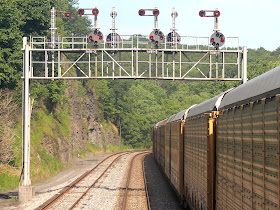The first piece of news is probably the most important. METRA appears to be in the process of re-signaling Pacific Junction aka TOWER A-5 on its Milwaukee District. Part of the interlocking on the North Line comprising the northern legs of the wye and both main track to a point in front of the tower have already been re-signaled and there is a brand new Darth gantry sitting in front of the tower itself. The west end of the interlocking appears to be next up. I am not sure if the tower is going to be closed seeing as how the all-relay plant could have already been placed under remote control, but I wouldn't be surprise.
The second piece of Chicago news is that I was able to confirm that the two crossover interlockings on the Chicago Blue Line Subway (Jackson St) have in fact been converted from pneumatic A-10's to electric M-3 point machines. For a bit of good news every time you see a small shelter or relay hut with windows on the CTA it does house a local control panel which might let them count as interlocking towers if they are used on a regular basis.
On the Chicago Line both CP-ENGLEWOOD and CP-513 have finally been re-signaled and had the position lights removed.
CP-ENGLEWOOD also had its westbound Darth Vaders removed and replaced with ones that can display Medium Approach Medium.
I believe that CP-513 may have had the replacement signals up since 2011.
No news on the re-signaling efforts around Toledo, but all the former P&LE signals between BRADDOCK and SINNS have also been replaced.
On the former B&O Keystone Sub the section of Rule D-251 operation between GREEN JCT and DRAKETOWN has been upgraded to 261 operation. The existing masts had reverse direction Vader heads added and additional solar panels were then installed.
Also the last CPL signals on the sub located east of Greene Jct at CASPARIS and BLUE STONE were removed and replaced with a new CASPARIS interlocking on #2 track.
One interesting development was that the non-interlocked crossover at HK TOWER was turned into a control point without power operated switches. So I guess CSX can save money when it needs to.
The re-signaling effort will also eliminate one of the 3 blocks in service between GREENS SPRING and PATERSON CREEK and replace it with a single gantry between Dans Run and Kerns Curve.
Everything else on the B&O Main has already been re-signaled so there is nothing new to report between there and Washington, but if you are interested here is an up to date video of the entire Magnolia Cutoff which is currently celebrating its 100th Aniversary.

























